 |
| April 16, 2019 | Volume 15 Issue 15 |
Designfax weekly eMagazine
Archives
Partners
Manufacturing Center
Product Spotlight
Modern Applications News
Metalworking Ideas For
Today's Job Shops
Tooling and Production
Strategies for large
metalworking plants
50 Years Ago: Apollo 11 prep includes Lunar Lander, flight hardware tests
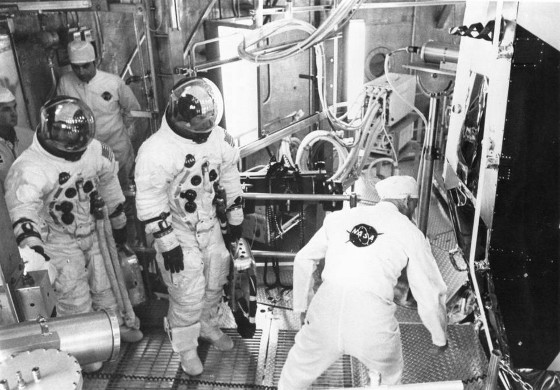
Apollo 11 back-up crewmembers Fred Haise (left) and James Lovell about to enter the Lunar Module for an altitude test.
[Countdown Series: 50th anniversary of Apollo 11]
By John Uri, NASA's Johnson Space Center
With the successful completion in March 1969 of the Apollo 9 mission that tested the Lunar Module (LM) in Earth orbit, NASA's confidence rose that President John F. Kennedy's goal of landing a man on the Moon and returning him safely to Earth before the end of the decade was achievable. Apollo 10 would carry out a dress rehearsal of the landing in May, and it was hoped that Apollo 11 would complete the actual landing in July. However, much work remained before that could be accomplished.
Flight hardware for the Apollo 11 mission was undergoing testing at the Kennedy Space Center. In the Vehicle Assembly Building, the three stages of the Saturn V rocket were in checkout following their stacking in February and early March.
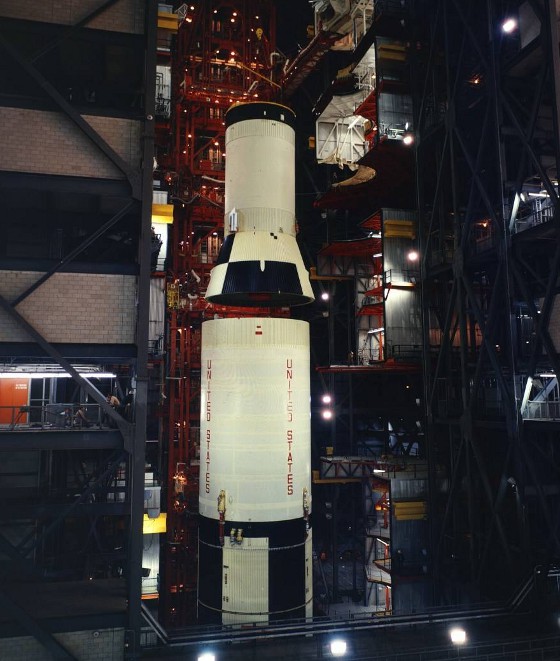
Stacking of the third stage onto the Apollo 11 Saturn V in the VAB.
In the Manned Spacecraft Operations Building, the prime crew of Commander Neil A. Armstrong, Lunar Module Pilot Edwin "Buzz" Aldrin, and Command Module Pilot Michael Collins tested their Command Module in the altitude chamber, followed by their backups James A. Lovell, Fred W. Haise, and William A. Anders. Armstrong and Aldrin, as well as Lovell and Haise, also conducted altitude tests with their LM.
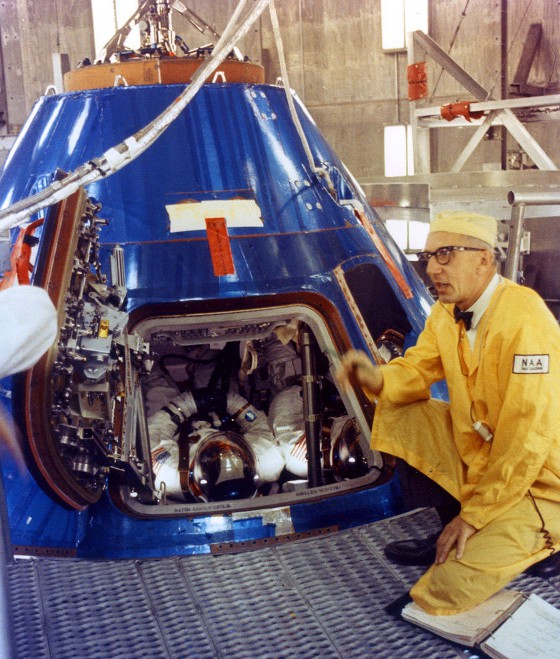
Apollo 11 crew inside their Command Module prior to an altitude test.
A 30-day simulation was under way in the Lunar Receiving Laboratory (LRL) at the Manned Spacecraft Center (MSC), now the Johnson Space Center in Houston. The LRL, a critical ground component of the Apollo program, was specially designed and built to isolate the astronauts, their spacecraft, and rock samples returning from the Moon to prevent back-contamination of the Earth by any possible lunar micro-organisms, and to maintain the lunar samples in as pristine a condition as possible. The simulation was the most complex test of the facility to verify that all its components would be ready to support crewmembers and their samples returning from the Moon.
A separate, seven-day simulation of the astronaut quarantine capabilities in the LRL's Crew Reception Area began on March 25. Fifteen NASA and contractor employees, most of whom would participate in the activities following the actual lunar landing mission, demonstrated the logistics of maintaining astronauts and support staff in isolation. All biological barriers were operative during the simulation, and the only contact test personnel had with the outside world was via telephone or through glass walls.
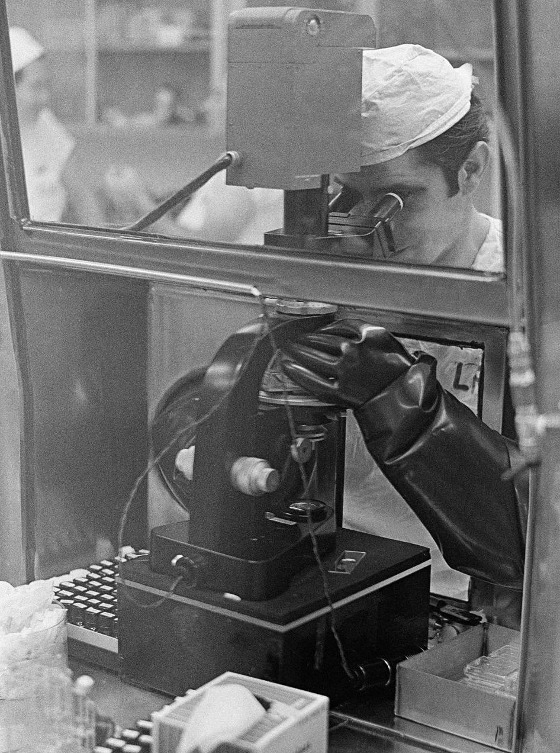
A technician uses a microscope inside a glovebox during the LRL simulation.
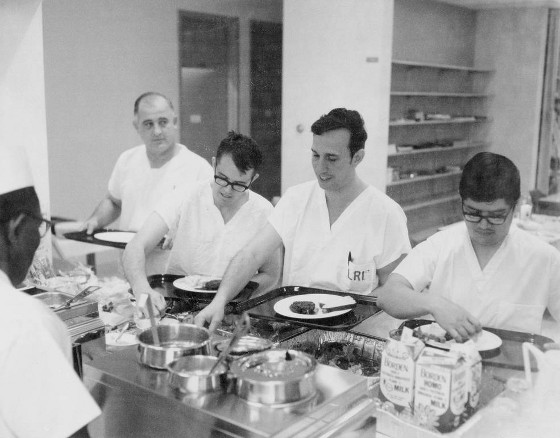
Staff in the LRL's Crew Reception Area galley during the simulation.
The first part of the test included the simulated arrival of lunar materials and film, followed the next day by the arrival of the stand-in crew. The last part of the test included the process for releasing the crew and personnel from quarantine. Earlier in the month, a successful simulation of recovery and quarantine operations with the Mobile Quarantine Facility was completed aboard the USS Guadalcanal in conjunction with the recovery of the Apollo 9 crew.
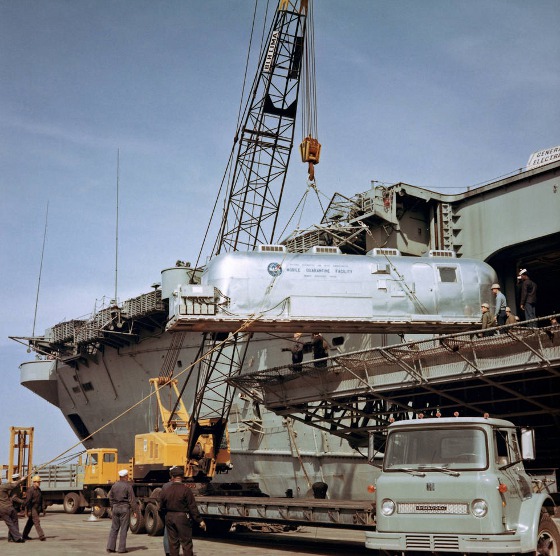
Mobile Quarantine Facility being lifted from the USS Guadalcanal prior to transport back to Houston.
To certify the LM for lunar landings, engineers at MSC conducted drop tests with Lunar Module-2 (LM-2) in the Vibration and Acoustics Test Facility (VATF). The series of five drop tests began March 21 and were completed in early May. NASA originally built LM-2 for a second unpiloted test flight of the spacecraft, but the first test during the Apollo 5 mission in January 1968 was so successful that NASA deemed a second flight unnecessary. [Designfax Editor's Note: Wow! That showed some confidence.]
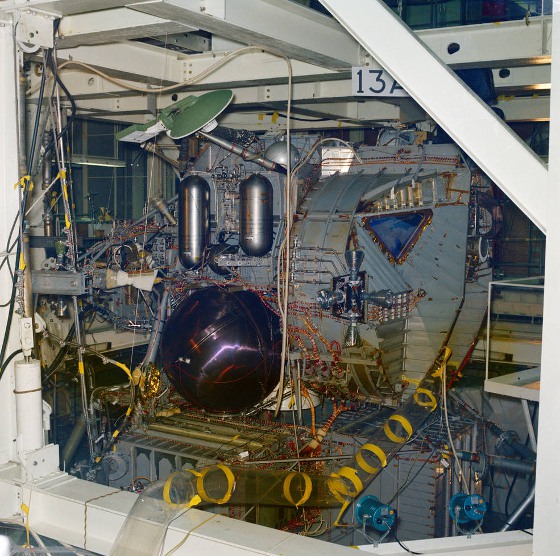
LM-2 in the test stand in the VATF prior to a drop test.
By using LM-2, a flight-like vehicle with all subsystems installed, engineers evaluated the durability of those systems. Engineers dropped LM-2, instrumented with accelerometers, from heights of 8 to 24 in. onto pedestals of varying heights and slopes to simulate landings on rough lunar terrain. The vehicle passed with flying colors and was certified for the first lunar landing.
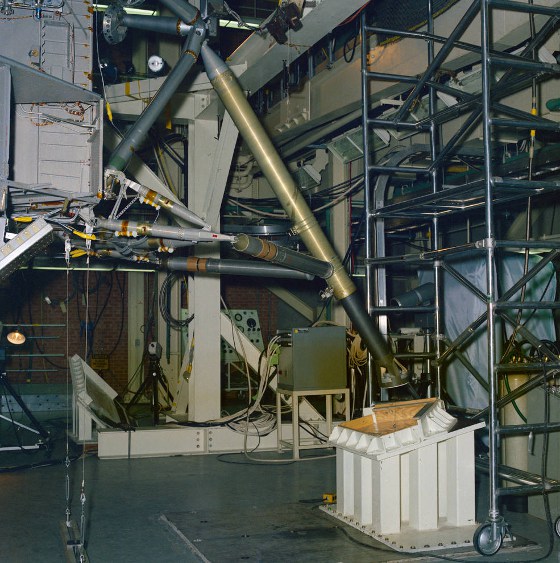
Landing leg on LM-2 in the VATF test stand.
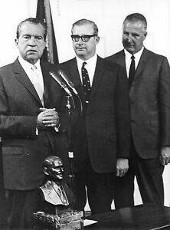
In the White House, President Nixon (left) announced the nomination of Paine (middle) as NASA's third Administrator, as Vice President Agnew looked on.
In a White House ceremony back on March 5, President Richard M. Nixon had announced that he was nominating Thomas O. Paine, Acting NASA Administrator since October 1968, to be NASA's third Administrator. The Senate confirmed the nomination on March 20, and Paine assumed the role the next day, being sworn in by Vice President Spiro T. Agnew. On March 28, the nation learned of the death of former President Dwight D. Eisenhower at the age of 78. As President, Eisenhower was instrumental in the establishment of NASA in 1958 and supporting the agency in its formative years.
Testing the LLTV
On April 7, 1969, the Lunar Landing Training Vehicle (LLTV) resumed flight operations at Ellington Air Force Base near the Manned Spacecraft Center in Houston. The LLTV was a critical tool for astronauts training to land on the Moon, serving as a high-fidelity simulator of the Lunar Module's (LM) flying characteristics, especially of the final 500 ft of the descent.
Bell Aerosystems of Buffalo, NY, built three copies of the LLTV, delivering them to Ellington late in 1967. As astronaut Neil Armstrong later described the vehicle, "It was a contrary machine, and a risky machine, but a very useful one." The first man to pilot a LM to the Moon's surface had personal experience with the fickle nature of the training vehicle.
On May 8, 1968, while flying a predecessor of the LLTV called the Lunar Landing Research Vehicle (LLRV) Armstrong ejected from the craft when sensors failed to tell him that he was out of attitude control fuel and he lost control of the vehicle. He parachuted to safety, but the LLRV crashed and was damaged beyond repair.
VIDEO: Armstrong LLRV crash.
On Dec. 8, MSC Aircraft Operations Office Chief Joseph S. "Joe" Algranti also had a close call when he ejected from LLTV-1 just moments before it too crashed.
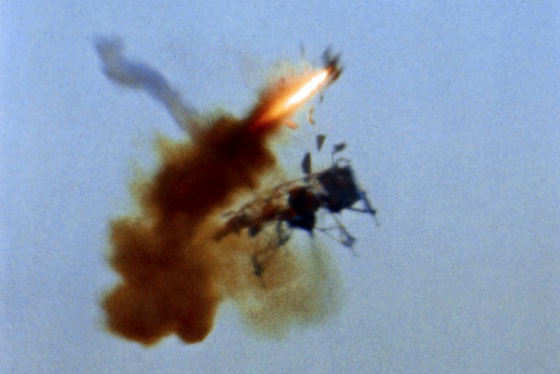
NASA pilot Algranti ejecting from LLTV-1 seconds before it crashed.
Following investigations into the crashes, NASA managers held a Flight Readiness Review (FRR) for LLTV-2 on March 10, 1969, and identified some open work before agreeing to resume flights with test pilots. During a second FRR on March 31, managers were satisfied with the changes made and decided to allow pilot flights to resume. A series of 12 pilot flights were planned before clearing the LLTV for astronaut training flights.
The open-framed LLTV (and its precursor test vehicle LLRV) used a downward-pointing turbofan engine to counteract five-sixths of the vehicle's weight to simulate lunar gravity, and LM-like thrusters for attitude control. One of the changes made to the vehicle since the crashes was to increase the output of each of the 16 attitude control thrusters from 60 lb to 90 lb to give the pilots better handling.
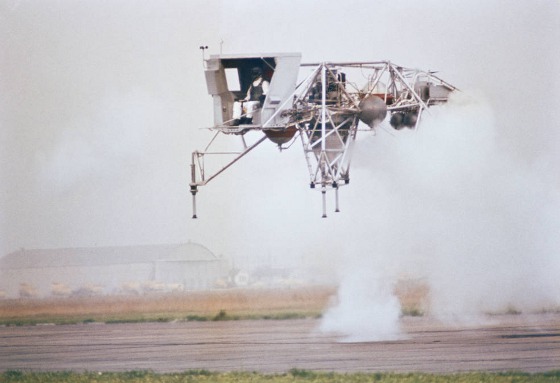
Pilot Ream flying LLTV-2 on its first flight after flights resumed in April.
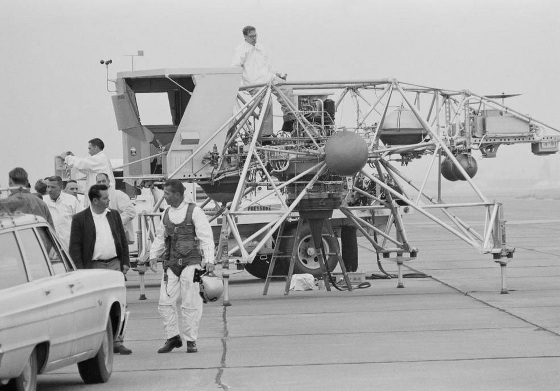
Ream walking away from LLTV-2 after the successful flight.
MSC pilot Harold E. "Bud" Ream, a veteran of 35 previous LLRV and LLTV flights, including LLTV-2's first two flights, was at the controls on April 7. He first hovered the vehicle at about 50 ft altitude to check out its systems and evaluate its flying characteristics with the increased thruster output. Then he flew the vehicle through three takeoffs and landings, with each cycle using up about 200 lb of the total of 735 lb of hydrogen peroxide fuel loaded into the propellant tanks.
An incremental decrease in mass provided an opportunity to evaluate the LLTV's flying characteristics over a range of weights. This first flight met all test objectives. A series of flights of LLTV-2 through early June expanded the operational envelope of the vehicle and resolved electromagnetic interference issues with Air Force radars at Ellington that were discovered during the flight test program.
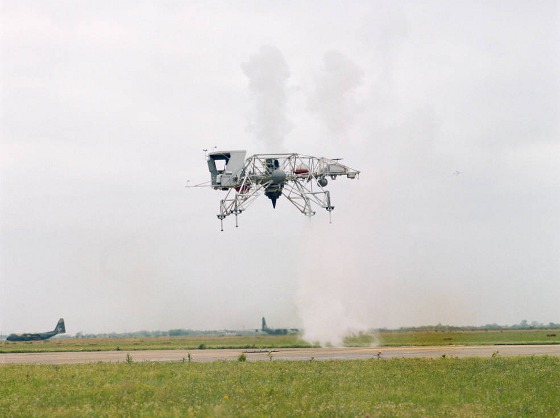
LLTV-2 test flight on April 10 at Ellington AFB.
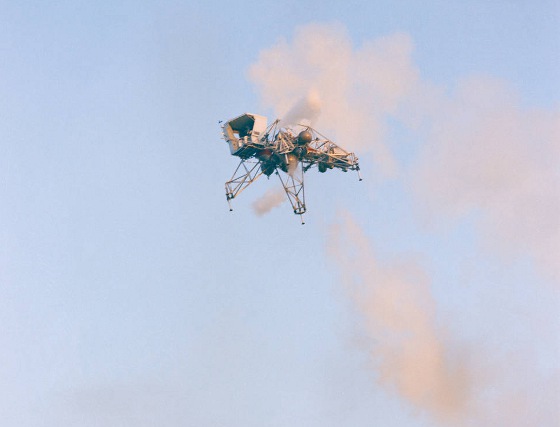
LLTV-2 test flight on April 14 at Ellington AFB.
Management cleared astronauts to fly LLTV-2 in June 1969, and Armstrong completed his training flights just four weeks prior to the Apollo 11 mission. He made 21 flights in the LLRV prior to the May 1968 crash and 8 in the LLTV in June 1969. Armstrong credited this valuable experience with being able to successfully guide the LM Eagle to the lunar surface on July 20, 1969, meeting President John F. Kennedy's goal of landing a man on the Moon before the end of the decade.
Watch a 1971 NASA documentary "300 Feet To The Moon" about the LLTV here.
Published April 2019
Rate this article
View our terms of use and privacy policy
